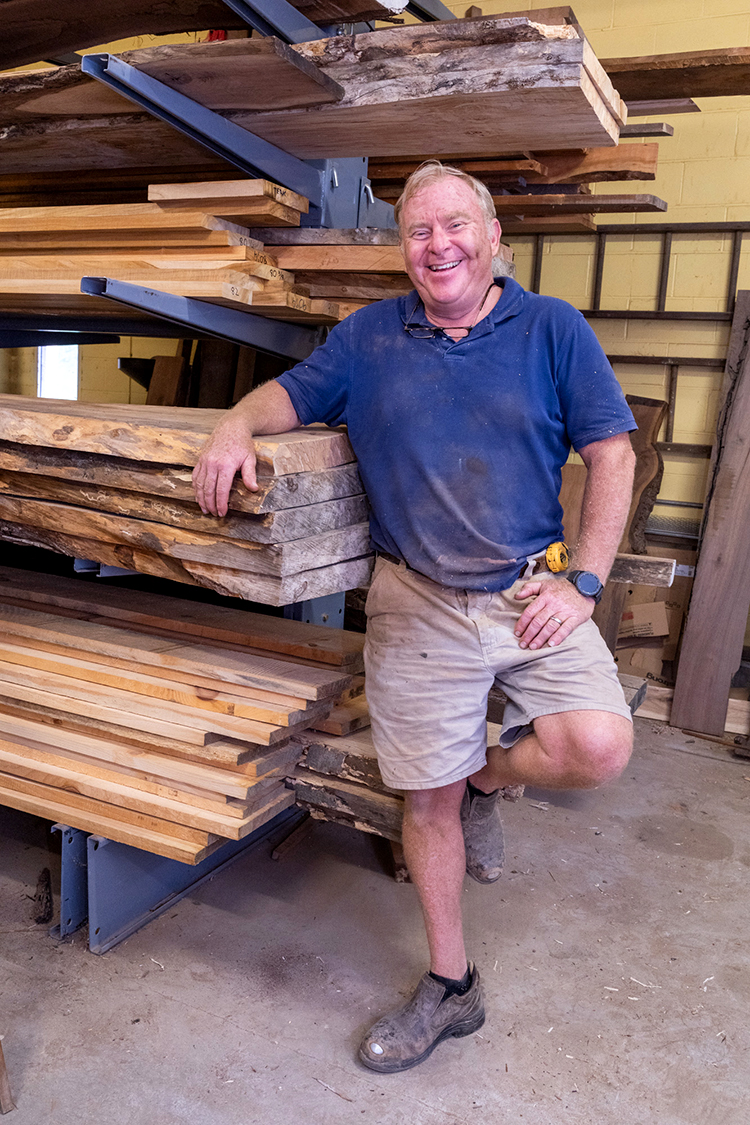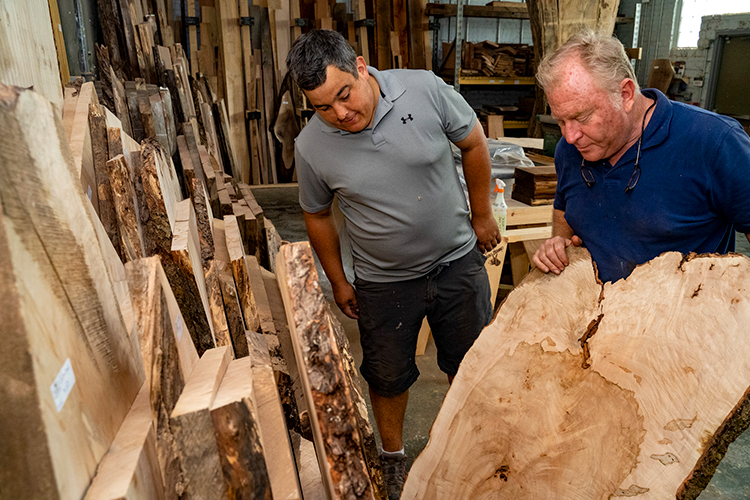By Claire Marie Porter
It’s the imperfect trees that make a beautiful piece of furniture for John Duffy of Stable Tables.
“I don’t really consider myself an artist or anything like that,” Duffy explains. “I’m more of a business person.”
Stable Tables, he says, began after he bought a table from a carpenter in Maryland and had to wait out a 14-week backlog to get it. He saw a need for handcrafted tables that were customizable, and locally made. He adds that he was an executive telecom operator, and was looking for something else to do.
“My [real estate business] partner is the one who really helped me get started,” says Duffy, referring to Chris English, a carpenter by trade. “He’s a general contractor and can make anything.”
Duffy, on the other hand, got his start making tables in 2003.
“The first table I made for Stable Tables was the first table I ever made,” he says.
The company mainly sells tables and countertops, but Duffy says it occasionally also makes benches, tables for conference rooms and desks as well as side tables and coffee tables.
The wood is mostly salvaged, and comes from trees felled by storms, age, or disease; old buildings or barns; and salvage companies — most of which would otherwise end up in a landfill.
There are enough trees dying from
natural causes that there is no reason to buy trees from a mill that are being harvested, Duffy says. Most are fallen, some are dead, and occasionally a developer might be cutting down trees after someone bought land and is trying to clear it.
The table bases are also made of salvaged material. One of his favorite materials, unique to Stable Tables, is made from the sifter of a mulch grinder, a heavy piece of metal that resembles a Connect Four game board. Repurposed scaffolding, old porch posts, and cast iron knitting table legs, are some of the other materials used.
Customers want things that are unusual, says Duffy, with custom sizes and custom finishes. They may have already been to a restoration furniture store and found they can’t get exactly what they want.
“Live edge” tables are a specialty that is in high demand, where the wood’s edge isn’t sanded straight, but left with its
natural curves.
Book-matching is another method Stable Tables uses, which involves placing two pieces cut from the same tree, one after another, joining them side-by-side with the grain aligned so that they create a mirror image of each other. The result is eye-catching and highly desirable.
Over time, Stable Tables has evolved from building rustic to more contemporary-style furniture.
“I don’t really make things your grandmother would have,” says Duffy. Adding that customers often think they want something rustic, when what they really have in mind is actually quite modern.
There is no cheating when it comes to the process of making a table. It’s a long process that requires properly curing wood. When a mill first gets a log, it has to sit in log form for one year per inch, in order to properly air dry. Then, it can go into a kiln.
The best tables are usually the most damaged trees, says Duffy. The company’s most supportive business partners are insects and fungi.
“I look for wood that’s already got crazy stuff going on in it,” he says.
For example, maple is not a not a very exciting wood, says Duffy. It’s just a plain light brown, usually used for painting or staining. But a lot of maples tend to die from either mushrooms or a bug that bores into the plant tissue causing clusters of inky black spots.
“They do really cool things to the wood,” says Duffy.
The mushrooms cause “spalting,” a wood coloration that resembles tiger stripes. It can be found in dead trees or live trees with many mushrooms attached.
“In the case of maple it enhances the way the wood looks,” says Duffy.
But the mill has to know about the timing of spalting. The wood can’t sit too long. It’s like aging a grape.
“Because if it goes too far, the wood gets all punky and soft and it can’t be used,” says Duffy.
Currently, Stable Tables is comprised of two full-time employees and one part-time employee. And it will stay that way, according to Duffy.
“I enjoy it because I don’t have a lot of people working for me,” he says. “I’ll never make the money I could make, because I want to build stuff; I don’t want to manage people.”
Duffy is involved in the making of each and every table, whether this means picking up, cutting, or mining the wood; building or sanding the tables; or dropping off the resulting wood scraps, which they donate to wood shops at local schools.
“I want to know what that table is going to look like at the end,” he says. “I’m very hands-on.”
His greatest satisfaction comes from choosing a wood that’s so unique and beautiful, it just needs a good presentation, then “people look at it and think: ‘that’s art.’”
He’s in the sweet spot for a small business, he says.
“I’m happy every day,” says Duffy. “I sleep well.”








We had John make our dining room table back in 2011 and asked him a year later to make a coffee table and blanket chest – all pieces we still use and love! And get tons of compliments on.